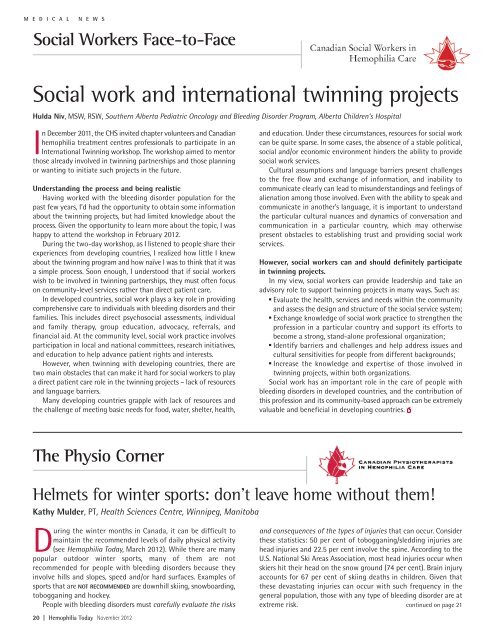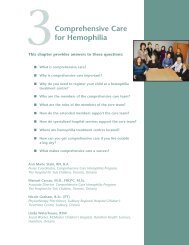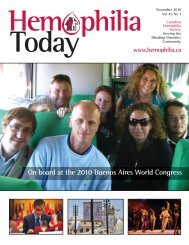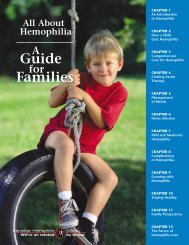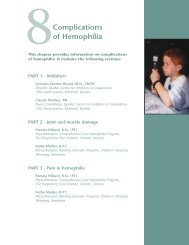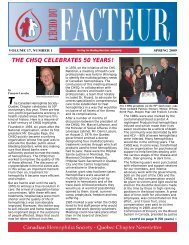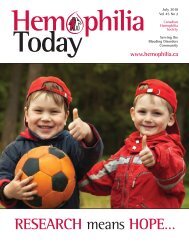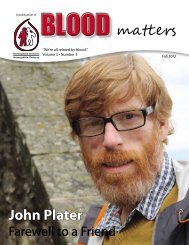Canadian Hemophilia Society
Canadian Hemophilia Society
Canadian Hemophilia Society
Create successful ePaper yourself
Turn your PDF publications into a flip-book with our unique Google optimized e-Paper software.
M E D I C A L N E W S<br />
Social Workers Face-to-Face<br />
Social work and international twinning projects<br />
Hulda Niv, MSW, RSW, Southern Alberta Pediatric Oncology and Bleeding Disorder Program, Alberta Children’s Hospital<br />
In December 2011, the CHS invited chapter volunteers and <strong>Canadian</strong><br />
hemophilia treatment centres professionals to participate in an<br />
International Twinning workshop. The workshop aimed to mentor<br />
those already involved in twinning partnerships and those planning<br />
or wanting to initiate such projects in the future.<br />
Understanding the process and being realistic<br />
Having worked with the bleeding disorder population for the<br />
past few years, I’d had the opportunity to obtain some information<br />
about the twinning projects, but had limited knowledge about the<br />
process. Given the opportunity to learn more about the topic, I was<br />
happy to attend the workshop in February 2012.<br />
During the two-day workshop, as I listened to people share their<br />
experiences from developing countries, I realized how little I knew<br />
about the twinning program and how naïve I was to think that it was<br />
a simple process. Soon enough, I understood that if social workers<br />
wish to be involved in twinning partnerships, they must often focus<br />
on community-level services rather than direct patient care.<br />
In developed countries, social work plays a key role in providing<br />
comprehensive care to individuals with bleeding disorders and their<br />
families. This includes direct psychosocial assessments, individual<br />
and family therapy, group education, advocacy, referrals, and<br />
financial aid. At the community level, social work practice involves<br />
participation in local and national committees, research initiatives,<br />
and education to help advance patient rights and interests.<br />
However, when twinning with developing countries, there are<br />
two main obstacles that can make it hard for social workers to play<br />
a direct patient care role in the twinning projects – lack of resources<br />
and language barriers.<br />
Many developing countries grapple with lack of resources and<br />
the challenge of meeting basic needs for food, water, shelter, health,<br />
and education. Under these circumstances, resources for social work<br />
can be quite sparse. In some cases, the absence of a stable political,<br />
social and/or economic environment hinders the ability to provide<br />
social work services.<br />
Cultural assumptions and language barriers present challenges<br />
to the free flow and exchange of information, and inability to<br />
communicate clearly can lead to misunderstandings and feelings of<br />
alienation among those involved. Even with the ability to speak and<br />
communicate in another’s language, it is important to understand<br />
the particular cultural nuances and dynamics of conversation and<br />
communication in a particular country, which may otherwise<br />
present obstacles to establishing trust and providing social work<br />
services.<br />
However, social workers can and should definitely participate<br />
in twinning projects.<br />
In my view, social workers can provide leadership and take an<br />
advisory role to support twinning projects in many ways. Such as:<br />
▪ Evaluate the health, services and needs within the community<br />
and assess the design and structure of the social service system;<br />
▪ Exchange knowledge of social work practice to strengthen the<br />
profession in a particular country and support its efforts to<br />
become a strong, stand-alone professional organization;<br />
▪ Identify barriers and challenges and help address issues and<br />
cultural sensitivities for people from different backgrounds;<br />
▪ Increase the knowledge and expertise of those involved in<br />
twinning projects, within both organizations.<br />
Social work has an important role in the care of people with<br />
bleeding disorders in developed countries, and the contribution of<br />
this profession and its community-based approach can be extremely<br />
valuable and beneficial in developing countries.<br />
The Physio Corner<br />
Helmets for winter sports: don’t leave home without them!<br />
Kathy Mulder, PT, Health Sciences Centre, Winnipeg, Manitoba<br />
During the winter months in Canada, it can be difficult to<br />
maintain the recommended levels of daily physical activity<br />
(see <strong>Hemophilia</strong> Today, March 2012). While there are many<br />
popular outdoor winter sports, many of them are not<br />
recommended for people with bleeding disorders because they<br />
involve hills and slopes, speed and/or hard surfaces. Examples of<br />
sports that are NOT RECOMMENDED are downhill skiing, snowboarding,<br />
tobogganing and hockey.<br />
People with bleeding disorders must carefully evaluate the risks<br />
20 | <strong>Hemophilia</strong> Today November 2012<br />
and consequences of the types of injuries that can occur. Consider<br />
these statistics: 50 per cent of tobogganing/sledding injuries are<br />
head injuries and 22.5 per cent involve the spine. According to the<br />
U.S. National Ski Areas Association, most head injuries occur when<br />
skiers hit their head on the snow ground (74 per cent). Brain injury<br />
accounts for 67 per cent of skiing deaths in children. Given that<br />
these devastating injuries can occur with such frequency in the<br />
general population, those with any type of bleeding disorder are at<br />
extreme risk. continued on page 21


